At the gates of 2012 I had a test unit for a couple of days, with which I starred in one of my most epic episodes as a driver: rushing a tank to 6 kilometers of autonomy, and with everything against me. I got away with it, but what an experience. This time I'm back at it again. Nissan has given us a unit for more than enough time to reproduce a realistic use of the car.
The Leaf is currently in its final months of commercial life, having sold more than 250,000 units. It is the most successful electric car of all time. Five years after its launch, the 30 kWh batteries were announced, allowing it to reach up to 250 km according to homologation. This is the version we're going to talk about, as soon as it came out it was the pure electric car with the longest range. It is already surpassed by several rivals, but it was once again the first, meaning the first affordable with that capacity.
Design
The Nissan Leaf has hardly changed since it first appeared on the market. There was a slight redesign of the front grille -symbolic- to improve the Cx from 0.29 to 0.28. That value is nothing surprising compared to the 0.24 of the Tesla Model S or Toyota Prius (4g), but it's just that the compact five-door body isn't as good as a Kammback or sedan. By the way, the headlights are what they are... to reduce air turbulence in the mirrors. They lack being integrally LED to be more efficient.
The rest of the changes are testimonial, new radio antenna, new wheels and additional body colors. It came out good, period. It's better made than the Renault ZOE, it doesn't feel as tall as the Renault ZOE, the components are of better quality (see LED rear lights instead of halogen) and it's more of a car. The version tested has 360-degree vision, i.e. a camera on the nose, two under the mirrors and another on the tailgate, which allows you to compose an aerial image of the car. A delight for parking.
The solar panels on the spoiler are for the 12 volt system, they will extend the life of the auxiliary battery. Their impact on range is negligible.
Some will say it's ugly, some will say it's just different. The BMW i3 is much more transgressive in its lines, this one prefers to be a middle ground between a traditional car and one that wants to show off. Of course, the little need for cooling conditions its design, very closed, that's why we see him so different. In the mid 90's it wouldn't have attracted attention, the grills didn't look like the mouth of the Cookie Monster. Nor does it have so many edges that make it look like a sword carrier on wheels.
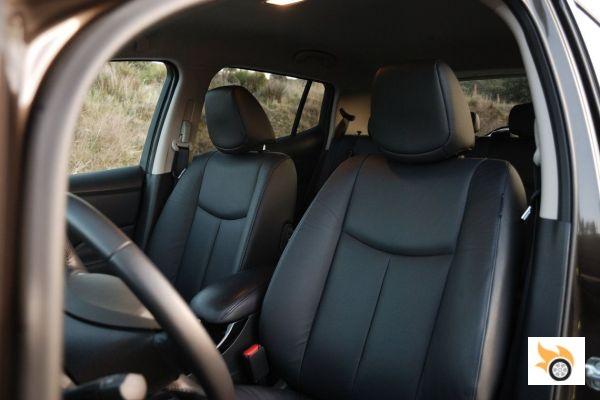
Cabin
Although this unit is priced at over 30,000 euros, in some ways it's a car with B-segment qualities. The dashboard is hard plastic, there are no rubber cup holders, the sun visors are not illuminated, the central mirror is not electrochromic and the steering wheel cannot be adjusted in depth. It is, however, better finished than the Renault ZOE, which is in the B-segment. The worst thing about the interior is the piano black, it stains when you look at it.
On the other hand, its soundproofing level brings us closer to the F-segment with a very refined and well insulated petrol engine. Fortunately, there is no sound of crickets or creaking, because with such a level of silence everything is noticeable. In this car you can hear a slight aerodynamic whistling noise at legal highway speeds, and you can also feel the wheels, which is normal if the engine is quiet. In some respects it is a futuristic car, especially for the welcome sounds it has.
It appears to be a car from a higher segment than it is, due to its comfort and silence.
In the specific case of the Tekna, there are such little things as heated leather seats, both in the front seats (individual) and in the rear bench. I can think of very few mainstream cars with heated rear seats, even if you pay extra. In addition, the steering wheel is heated, a luxury that we are starting to see more often in Spain (manufacturers have discovered that here there is also winter).
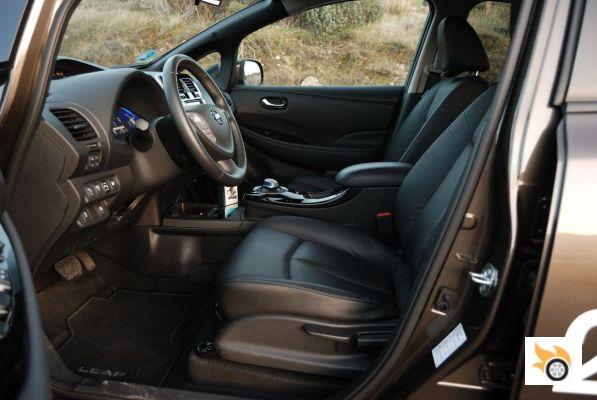
On a practical level is a fairly normal car, there is room to leave almost everything we carry. Compared to the last model, a second USB socket or an inductive charging system for mobile phones could be missing. There are two compartments in front of the "change" and another one behind it, central box with a separate cover. The glove box has delayed opening. It would have more storage spaces if the "gearbox" took up less space. And the handbrake? It is operated with the left foot, it is a pedal.
To the left of the driver there are more buttons than usual, although most of them are not designed to be used while driving. Above are the controls for the on-board computer and the brightness of the screen, not the best location, for that it would have been better to reuse the steering wheel. The steering wheel controls the phone, audio system and speed limiter/regulator.
The instrumentation is separated into two screens. The upper one shows speed, accumulated driving efficiency (trees are growing), outside temperature, time and little else. Most of it is displayed on the central instrumentation, which has become a bit old-fashioned, as it hasn't evolved since 2010. At all times you can see the autonomy, something very important in a car like this.
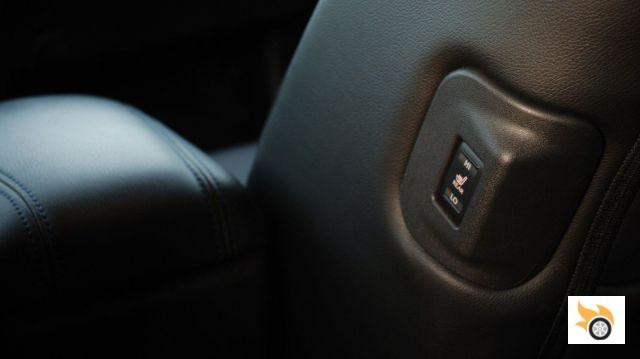
It has five seats. Four adults of average height will be comfortable, although it should be noted that the rear bench is a little low and the knees go up more with respect to the hip. In the 2010 model the roominess was worse because you couldn't get your feet under the front seats easily. In the front it's easy to find a good driving position even though the steering wheel is only height adjustable.
The middle rear seat is adequately padded and is wide enough. In this car it is frankly difficult to get tired of this seat, as over 3 hours on board seems complicated for reasons of weight (come on, the autonomy). Although the central tunnel is a bit bulky (it grew in 2013) you can place your feet on the sides without any problem.
The heating can be programmed so that the car is already pleasant at a set time, depending on the day (e.g. working days at 7:30).
To highlight the tremendous climatic comfort of the car. At temperatures close to zero the heat pump heating works almost immediately, and the integrated seat heating tastes like heaven. Thanks to the heated steering wheel rim, there's no need to drive with gloves on. On the other hand, the car is well insulated from the noise of others, because the car itself doesn't generate much. I appreciated it while I was waiting for a recharge while in the area there were construction works (radials, workers chirping and so on). If that's a problem, the BOSE sound system sounds very good, and doesn't produce annoying noises or vibrations when playing music at full blast.
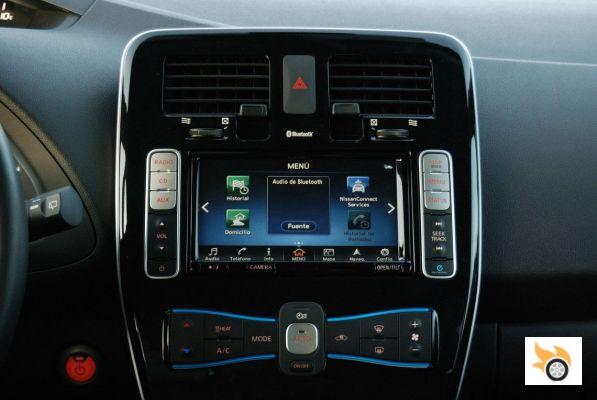
One of the key components of the car is the Nissan Connect module, with audio system, navigation and phone, and a small set of features related to electric charging, charging point availability, etc. It doesn't have app support, but it does support apps. It doesn't have app support, but at least it can report whether a special charging point is free or not. Some functions can be controlled with a mobile app, such as programming the heating or knowing the charging rate.
A CD player is hidden underneath the 2-DIN display.
It takes some time to master the system completely, so don't try to learn it on the go or you'll have more than one scare. The instant consumption function is really useful, so you know what's worth removing to gain autonomy and what's silly to switch off. With the voice control you can give some instructions, but it requires training. In other Nissan models this module has more features, such as some applications, Google Send to Car...
The vision of the peripheral cameras is shown on this screen, as well as the reversing one. However, the front camera has no safety functions: it doesn't read signals, nor lane markings, nor detect vehicles... it only shows an image on the screen. In general it lacks advanced safety systems, nor does it warn of vehicles in the blind spot, nor is there automatic braking. We forgive the fatigue warning, it is very difficult to justify it.
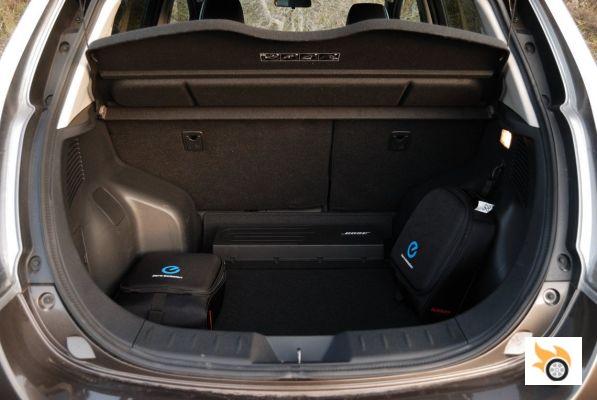
Let's move on to the boot, which grew in 2013 and remains the same now. The Visia and Acenta have 370 litres of capacity, but the Tekna only 355 litres due to the BOSE sound system. It carries two small backpacks. One of them stores the occasional-use charger, which plugs into any Schucko socket that gives at least 10 amps at 230 volts. The length of the cable is about 4 meters, and cannot be extended. This pouch is perfectly fastened, underneath and with a ring, it does not come out easily.
The second bag has the cable for mode 3, that is, from the charging point to the car, although I have never had the need to use it. There are charging points with cable included and others without, of course all the fast ones have it. The connection and disconnection procedure is so easy that a child can learn it in two minutes watching two drawings.
Otherwise, it's a very simple boot. Considering it's not a car to go on a trip, it has what's necessary and it's equivalent to an average compact. It lacks a few things like a double-height tray, a power socket or opening the boot with your foot underneath. For a car that is used every day, it doesn't need anything else. In fact, that's what it was designed for.
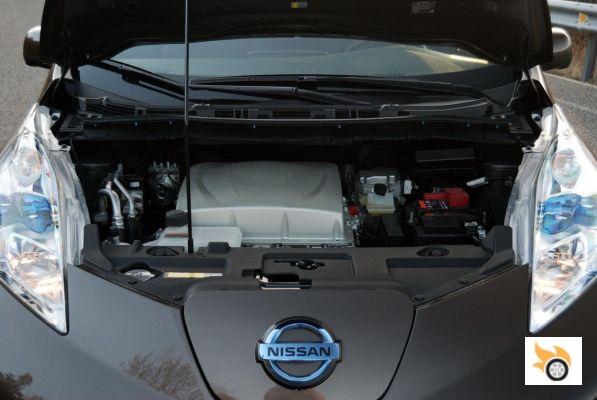
Technology
The Nissan Leaf is powered by an 80 kW (109 hp) synchronous AC motor, which gives it all between 3,000 and 10,000 RPM. Maximum torque is 254 Nm; it delivers that power to the front axle with a single speed reduction gearbox and free differential; it's silly to complicate it any further. In this sense, the Leaf is exactly the same as when it was launched on the market, in the Spanish case, mid-2011. The ZOE has received changes in the engines.
The fundamental difference between the 30 kWh model and the 24 kWh is in the chemistry of the batteries, more optimized, and the internal arrangement of the cells, which remain 192. The gain of 6 kWh capacity has a toll of 21 kilograms. In the case of the ZOE, the range has almost doubled (from 22 to 41 kWh) with an increase of 15 kg. In fairness it has to be said that there is a year's difference, the ZOE z.e. 40 - which we recently tasted - was announced at the 2016 Paris Motor Show.
Unless you put your foot down, it's rarely going to pull more than 60 kW (82 hp).
The rest remains the same. The batteries are air/water cooled and unless there are extreme temperatures performance is going to be very stable, which I corroborate. Being located under the floor, the center of gravity of the car is closer to the ground, the difference is very noticeable compared to the Qashqai, but little compared to the Pulsar. The Leaf does not share a platform with either the Qashqai or the Pulsar. In 2013 it received changes in steering, brakes and suspension to get closer to the European taste; before it was a little more Japanese. Now it's a bit more Japanese, but it holds the car well.
The homologation of autonomy for the 30 kWh batteries is 250 kilometers. The data sheet itself states in the small print: "The actual range range is between 125-200 km with 30 kWh". In other words, Nissan isn't fooling anyone. I also tell you that the best range forecast I've seen on the screen was 200 km, and without having reached the maximum capacity, 96%. Hallelujah brothers, finally we see realistic information in this regard. I want to highlight this fact: this Leaf has moved with height differences of up to 400 meters, not in a smooth place, where the numbers would improve.
30 kWh is roughly equivalent to the energy stored in three (3) liters of gasoline.
It homologates an electric consumption of 15 kWh, that is, it would give for 200 kilometers, not 250. Throughout the test I have not managed to lower the average -accumulated from the first kilometer- of 15 kWh, although the real consumption has reached 22 kWh/100 km per charge and more than once. The "worst" possible range can be set at 100 kilometers, intensive use of air conditioning and without watching the speed on the highway. Do you think it's a lot? Let's see what your car's range is when you're driving it, it'll be less than half that. The Leaf is capped at 144 km/h top speed.
It's equipped with an internal charger that operates at a minimum of 2.3 kW of power, and supports up to 50 kW at a fast charge point. Power is reduced as the batteries fill up, the last 10% takes a long time to charge, more than three hours in the worst case (10 amps), and the fast chargers don't improve that substantially: the last 6% takes 20 minutes. To get optimally to 100% at home you need to have a special charging point, but any plug will do the trick.
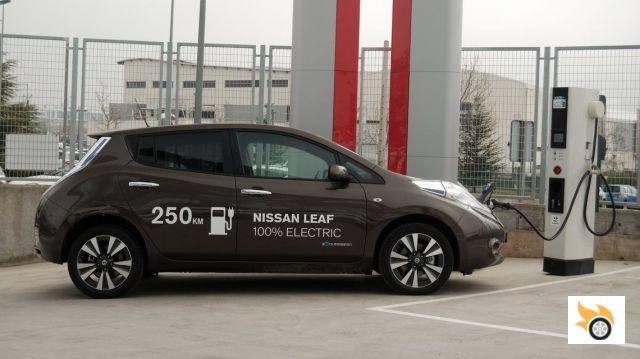
In my home, and with a margin of error of +/- 1 kWh, in eight hours pull 18 kW from the meter (using a digital one and with other consumers at 0); that is, an average of 2.25 kWh. This measurement was taken with the "emergency" charger, in the absence of a dedicated charging point. In other words, in 8 hours it recovers enough energy to cover about 120 kilometers. Other slow charging speeds are 3.5 kW and 6.6 kW (the latter only in the 30 kWh model).
What does work like a bitch is fast charging. The only public point I've used has been the metrolinera of Sainz de Baranda (Madrid), which does not require a subscriber card (Nissan did not provide them). You arrive, pick up the hose, plug in and tap twice on a screen. Free and no questions asked. You can also charge at any Nissan dealer that has that service.
With fast chargers you get more than half the charge in less than half an hour.
I have used this trick several times in different Madrid dealerships Ibericar, Iberauto and Grupo Gamboa, none have asked me for explanations, just changed the modus operandi. Sometimes the charger is ready to work without third party intervention, other times they have to remove a padlock, and other times a card is needed. In the best case, I got charging on the spot, in the worst case, it took 20 minutes to give me the damn card because the manager was on the phone (and it was about work).
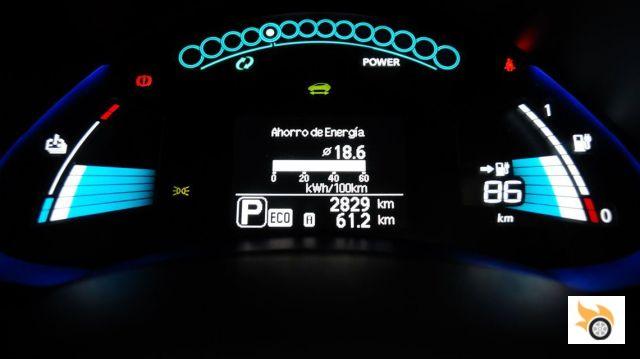
From what Nissan engineers told me in 2010, fast charging is not a problem for battery life if you don't use it multiple times a day. All the times I have done fast charges the temperature of the batteries did not rise, the process is very controlled. They are considered "to change" below 80% of their capacity, they are guaranteed eight years or 160,000 km, above the 24 kWh batteries. When the batteries are leased, it doesn't matter, it's included in the price.
The problem with the Nissan recharging joker is the business hours of the dealers, so you can't use it at any time. It is convenient to have subscriber cards for payment charging points, see those of IBIL, which allow you to recharge at 54 cents/kWh and a minimum of 5 euros. In other words, the batteries are filled at a cost very similar to that of a traditional petrol/diesel, and they get you out of trouble in 15-30 minutes. Of this network there are a few chargers in Madrid, which is where I have moved. Obviously any socket you find in a car park will do, although they are not always intended for that use: if you don't ask and no one gives you the "touch", it will do.
With time discrimination you can charge at 6 cents/kW, i.e., full for less than 2 euros.
The most convenient for those who have an electric car is to have the charging point well installed, with the maximum power available, its security measures, etc.. To charge at 16 amps (3.5 kW) you need to have 4.4 kW of power contracted. In my case, with 3.5 kW contracted, I can charge at 10 amps (2.3 kW), without turning on other appliances that approach the power limit. Anyway, as I always did it at night and coinciding with my sleep, I didn't care much or anything about that detail.
And how do you charge it? Very easy. You open the front hatch, where it has two connectors, one for slow charging and the other for fast charging. Both types of cables have locking positions, so when you close the car you can't remove them from the connector. Vandalism? Father, welcome into your bosom any cognitively retarded people who try to cut a cable through which so many amps pass, because they won't know what they're doing.
While the car is charging, three LEDs light up on the top of the dashboard. When three lights have illuminated and one is flashing, it is at least 66% charged. The charging status can be viewed remotely, the car is connected to the Internet. In addition, the Nissan Connect EV system lets you know if a charging point is available or not, in the event that the latter provides that information to the network. The fast charge points report the charging rate and battery level, but they don't always tell you how much time is left to go.
I have charged even when it was raining heavily, and you see me, I'm still alive, you just have to take some elementary precautions such as avoiding water touching the contacts. There are several safety measures in the whole process. If it refuses to charge in a socket, congratulations, the car has just diagnosed a problem in the installation, an electrician will find problems, bet on it. And that's it: no dirty hands, no smells, no problems for smokers or mobiles, no queues, no fuss. If it is imperative to take advantage of a schedule and avoid another, the car can be programmed to use the most favorable hours of rate also (even if it is plugged in, it will not consume).
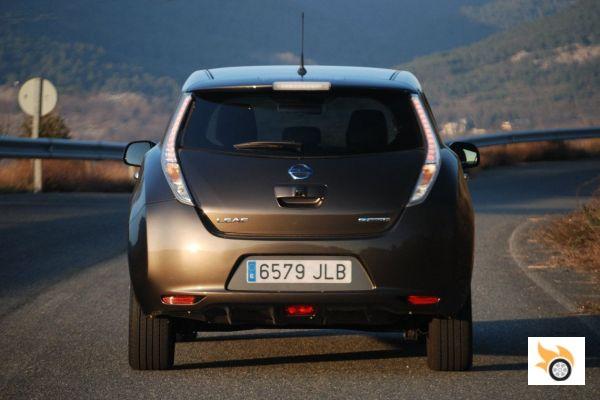
Driving
Driving the Nissan Leaf is like driving any automatic car, but with the smoothness of the best 12-cylinder and the perceived sound of being practically deaf. Being used to a hybrid, I was sometimes waiting for the combustion engine to "kick in", but not in this car. It is hypersilent, at low speed it causes a bit more to be audible to others, but it goes unnoticed if there is more noise.
This car is like anti-stress therapy. For those who suffer from dense traffic every day, and who will end up wishing they could kill someone, like Michael Douglas, they will notice an improvement in their quality of life. Getting into urban areas or traffic jams can even be seen as something positive: consumption can become symbolic. The driving is very zen, very pleasant, no thermal engine in this category provides a similar sensation.
Although there is only one gear ratio, it has two modes, normal and ECO. When using the latter, the range forecast goes up, the climate control wastes less and the accelerator is more sluggish, although at full throttle it does the same. In normal mode the 0-50 acceleration is very intense, less than 3 seconds, one of the fastest at any traffic lights. Doing this frequently is not the smartest way to make the batteries last longer. When not using ECO mode the throttle is very sensitive, especially at low speed, it can surprise you!
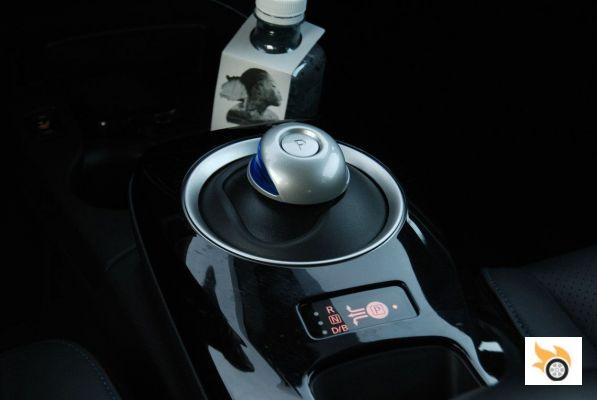
It also has two regenerative braking strategies, normal (D) and aggressive (B). The latter is suitable for urban areas, to maximise regeneration, or for descending a mountain pass with steep gradients. For example, for the Galapagar mountain pass, D is enough to go all the way down without using the brake pedal. In fact, a good Leaf driver will only use the central pedal to avoid a collision or to come to a complete stop, almost everything can be done with regenerative braking alone. On my usual commute I only have to press that pedal for a few seconds.
The accelerator helps to educate the right foot, it tends to return more than usual, thus avoiding wasting energy.
With cold or heavily charged batteries, electric recharging is very limited and may require more use of conventional brakes, but under normal conditions up to 30 kW can be recovered. For practical purposes, that's less than 1% of the range down the Galapagar pass (M-505). In reality, more than a recharge, it is a stretching of the autonomy. It is better to take advantage of inertia than to regenerate and then have to accelerate again.
It only takes 6.70 seconds to go from 80 to 120 km/h, an excellent time for a car of its power. However, the acceleration doesn't impress anyone at highway speeds, and the fuel consumption is much more noticeable at 90 than at 100 than at 120. This is elementary physics, the effort increases quadratically as a function of speed. The performance of this car can be equated to 1.5 l/100 km, so no one can say that it is not very efficient. In fact, it will beat any car with an internal combustion engine, even a hybrid. The batteries last "little" because they store little energy in relation to their size and weight, I remember the fact, like carrying 3 liters of soup.
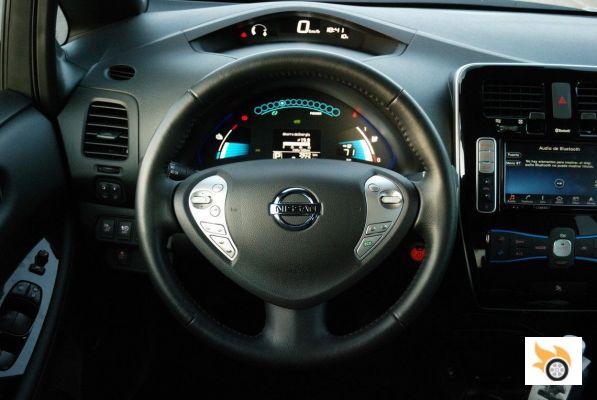
The previous times I tested a Leaf it was for less than 200 kilometers. This time it has been about 2,000, and Nissan has been kind enough to lend us the car for two weeks. The test has always been done in realistic conditions, trying to take the batteries charged as much as possible, or with a forecast of charging them without endangering my cardiovascular health.
The good thing about having +6 kWh is to have a little more peace of mind when making longer trips, it's only 800 euros more.
My routine is to do 120 kilometers a day. For that use I have not needed to go with the batteries charged to the maximum, using air conditioning and driving at normal speeds of my private car. In the worst case scenario, I left home with a 25% charge (without having charged overnight) and went to a fast charge point within reachable distance. When I got below 15% the "reserve" (low battery) lights up.
When I was 5 kilometers from the charging point and with a forecast of about 16 kilometers and 6%, I got the indicators like this: «—«. It was the only moment when I was afraid of being stranded. I managed to get to the charging point no matter what, and I arrived with 1% remaining. By the way, I didn't suffer any performance limitations. The pre-2013 model displayed the information until the very last moment, I had a range of 6 km when I was able to plug in. Apart from that one-off event, I wasn't nervous, I just had to be a bit more careful with the speed. In almost 13 years of testing cars, I have never pushed a "tank" so hard.
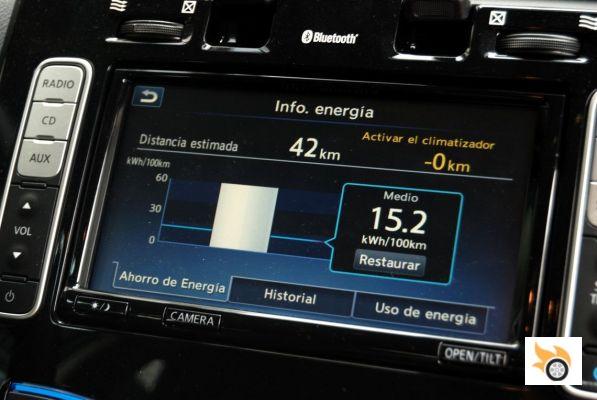
For example, one day I had the foresight to do almost 200 kilometers. Before the halfway point, I did a quick charge to 93%, and set the limiter to 100 km/h. I managed to cover all that distance arriving home just when the "reserve" came on. Another thing I must make clear is that I have not been cold or hot in order to conserve autonomy.
In the Nissan Leaf you can tell how much range you gain/lose by using the climate control. It's not worth being uncomfortable, sometimes the difference is 2-3 kilometers. Once the cabin has a stable temperature, the consumption of the air conditioning is minimal, even when you need the heating - heat pump (since 2013) - does not exceed 3 kW. Being a Tekna, the most equipped, it has heating in the seats and steering wheel rim. What's more, getting into the car warm is priceless living in a minimally cold area.
The difference between using them and not using them is irrelevant in terms of range. Nor is anything gained by turning off the low beam (0.1 kW) or high beam (another 0.1 kW), or disconnecting the BOSE stereo while the 2002 Professional DJs Session Trance is playing at full blast. You know I'm a very classic guy when it comes to tastes... In other words, there's no point in being cold, going without lights or being silent.
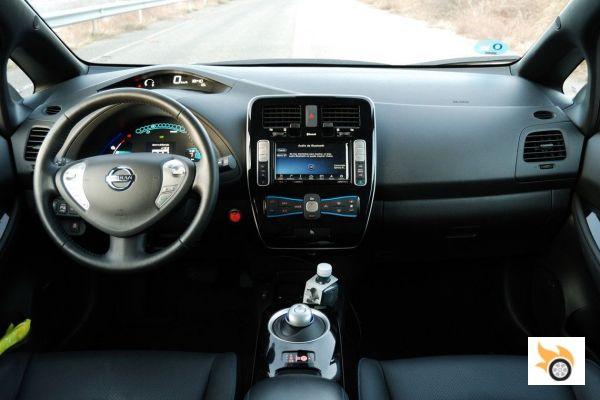
Moving on to the more piston-like part of its driving, the power steering has an excellent feel, but I would have appreciated less gear reduction, i.e. more wheel spin with the same steering wheel turn. This is noticeable when entering roundabouts at speeds 50% above legal, where, by the way, the car passes very well although it sways slightly. It's not very heavy, but it's closer to an SUV in terms of weight/power ratio, 109 hp for more than 1,500 kg; it does recover as if it had more power.
The tyres can be 205/55 R16 or 215/50 R17, suitable for this use, although there are more optimal tyres.
It's going to be very difficult for an average driver to put the Leaf in a dynamic predicament, even though the rear suspension is a torsion bar. It's very noble, docile and stable. Push it to the limit and you'll notice that the tyres aren't designed with the best cornering in mind, but they hold their own with great dignity. As an everyday car - or a domestic appliance, if you prefer - it performs perfectly. Moreover, it's very easy to drive, suitable for the amateur, the clumsy and the sporadic.
The front wheels grip so well that for the traction control to work you have to accelerate on slippery surfaces, on normal tarmac the traction is perfect. In addition, the driver can control the acceleration so well that I'd bet you could drive uphill on a slab of ice. It can move forward at the speed of a turtle, if that's the driver's wish. For parking, it's a great tip, and those who have popped a clutch for it will appreciate it the most.
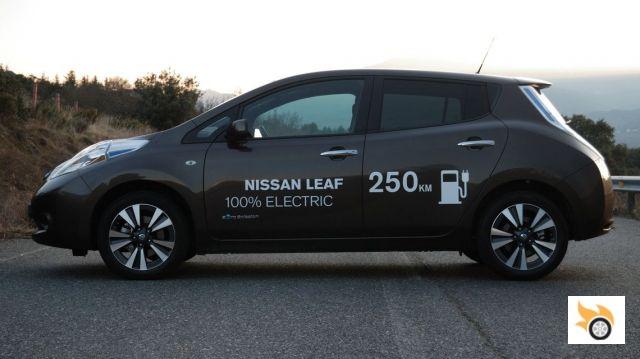
Conclusions
At this point you will all say to me: "yeah, it will be great, but it's not good for travelling". Yeah, that's the way it is. When there is a fast recharging network with 100 kilometers of separation between points, it will be possible to reach medium distance areas without fear of degrading the batteries, and in a reasonable time. Anyway, I consider it possible - in theory - to go from Madrid to Valencia, there is a fast charger halfway, but with a cruise of 80-90 km / h. At 120 km / h is impossible. At 120 km / h is impossible.
The Leaf is a car to use every day, to eat kilometers to the beast, without thinking about breakdowns, if oil rises or falls, in pollution, if it will be able to drive or park ... In fact, in the test has made almost 100 kilometers a day, its 30 kWh well charged give enough tranquility and allow to use the air conditioning moderately, that is, 22-24 degrees (which recommends the DGT).
Its approach could not be more honest, Nissan does not deceive, says what there is. Well, the "250 km of autonomy" sticker on this test unit was clearly not enough. But the 200 km is achievable unless the route is 100% highway, because it's the "high speed" that kills this car. If there's a larger portion of two-way roads, urban areas or traffic jams, all the better for it. A realistic range for every day -without thinking about conditions- is 120 kilometers, with an extra safety margin, half of what is homologated.
There are other advantages to consider, such as being able to have heat on the spot, and not having to wait for the obsolete internal combustion engine to generate heat. Moreover, the air conditioning can be programmed so that when we get into the car it is already to our liking, without reducing the autonomy: at 5 degrees in winter driving in shirtsleeves, not with as many layers as an Eskimo. This does not reduce the autonomy, the cost of air conditioning is assumed by the external electrical network.
The feel of the brake can be confusing at first, it is more realistic in a normal hybrid.
You can count -optionally- on a Nissan with a conventional engine for 14 days a year, no more than 7 consecutive days, for those holidays for which it is not useful. It is not cheap to move it, it is the following: its cost per kilometer is unbeatable by any non-electric, it is checked every 30,000 kilometers (inspection and change of cabin filter), and every 60,000 kilometers the brake fluid is changed. By the way, the brake pads can have more than 200,000 km of life, word of pucelano taxi driver (the pioneer in Spain).
Nissan gives us the choice between owning the batteries or renting them monthly for a lower initial price. That said, if you don't abuse fast charges, you won't need to change batteries until you get bored of it. As much as the electricity bill rises, we will only look at what we stop spending on dinosaur juice, which more than 60% is used exclusively to pollute (not to move the vehicle). When I got my electricity bill I didn't notice a significant jump compared to my normal usage.
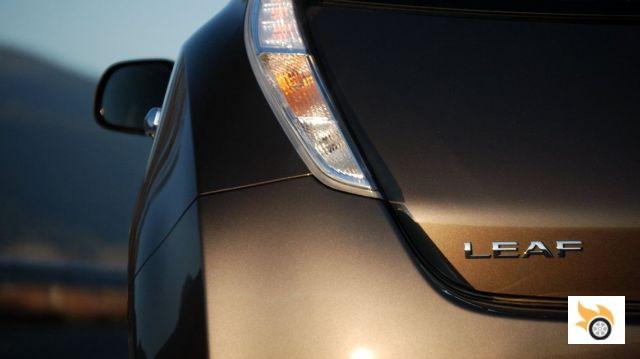
Several of the Leaf's rivals already have more battery capacity and run more kilometres, but very few consume less energy or are cheaper all things considered. It saves everywhere, even in parking, in cities like Madrid you can park for free in green or blue zone (prior communication to the City Council, eye). You can sneak into the bus lane /VAO, the workshop will not suffer, you can charge at home without queuing or stain your hands ... many advantages and few drawbacks. And if you happen to be passing by the Sainz de Baranda electric station, you will be able to recharge for free, taking advantage of the Metro's surplus.
For a person who does 120 km a day -or a little less- being able to charge it every day to almost 100% is an ideal car, it has plenty of autonomy. In some places you can stretch autonomy while shopping or doing some business ... if the chargers have not physically disappeared -it has happened to me in two places- or if an idiot has not parked with a gasoline or diesel in an area reserved for electric. There is still a long way to go, but the worst phase has already passed, the one where manufacturers are convinced that there is business here.
At least in Madrid, with several Nissan dealers with fast charging service, you can get out of more than one trouble, and it is an after-sales service, free of charge. My advice is that, to judge it fairly, you have to try it first and use it for a few days. It will forever change our perception of the perfect utility car. With all the money you save with this car you can invest in a fun petrol car, one of those that waste energy and pollute, but make your body happy.
By way of closing, the 24 kWh model is only offered in the basic finish (Visia) and the 30 kWh version costs only 800 euros more. Therefore, except for those who have more than 100 kilometers of real autonomy, it is not worth it. The Leaf is available with battery mode in ownership or rental (lower initial price, but you have to pay installments each month depending on the mileage).

























